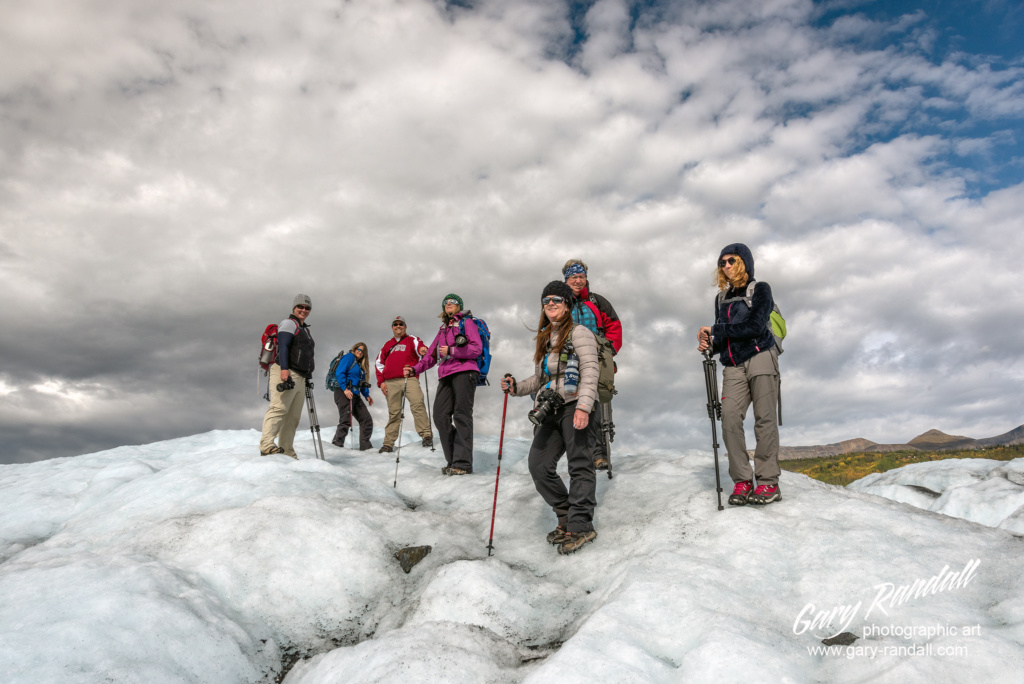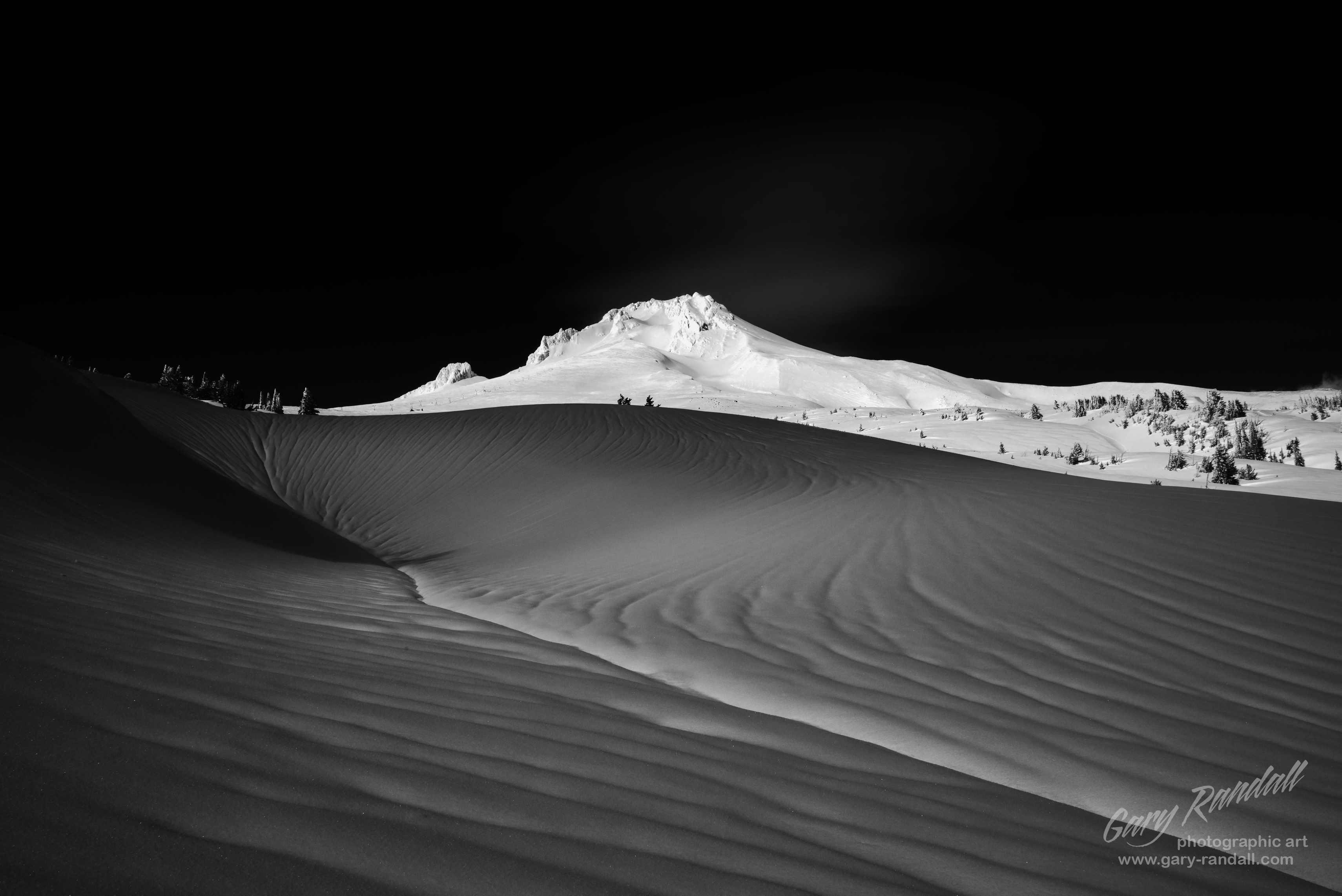It’s been another great year here at Gary Randall Photography. I hope that it was for you all as well. After all setbacks are considered, we’re thankful for the growth and progress that has taken place in life and business, including being included as a writer for the Mountain Times.
As I look back on 2016 I thought that I should share a few of the photos that were made and share what it took to get the shot. The photos might not be my most beautiful or technically brilliant but combine my memory of the moment with the resulting image and they’re some of my personal favorites. Consider this a year in review. I hope that that non-photographers enjoy them and that fellow photographers and photographic artists can learn or be inspired to push their work to be the best that it can be.
I hope that 2017 brings good health, happiness and many photographic opportunities to you.
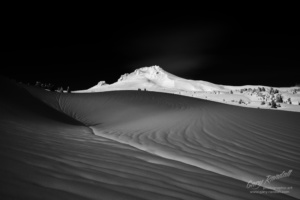
I started the year out near home with a monochromatic photo of Mount Hood from Timberline Lodge. Although this looks as if it was taken at night it was made on a bluebird day. The snow had been rained on causing these channels of water runoff creating the lineal patterns in the snow. After the patterns were made another snow storm came and covered them back up again but left them soft like folds in fine white fabric.
To get the photo I had to blaze a path through the deep snow to the point of view that I wanted. Of course I didn’t have my snowshoes, but luckily this was only about 20 yards from the Timberline Lodge parking lot.
Processing involved was simple using Adobe Lightroom. For the dark sky I polarized it to a darker blue with my circular polarizing filter. I then localized the exposure and contrast to the blue and darkened the zone to pure black. I then brought the whites and the zones between 0% and 100% to a point where the brightest was at 100% with each level between that would allow for the texture of the scene to be represented. You can see all of the detail including a sandy texture in the foreground of the freshly fallen snow.
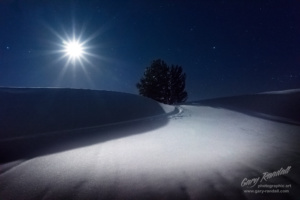
This photo is one of my favorites from this past year. After getting the previous Black and White photo of Mount Hood I decided to return again after dark to see what I could do with the scene at night, especially under the moonlight. This photo might be considered an unexpected benefit of looking all around me while I was photographing the mountain. This scene was behind me.
To get this photo I used my tripod to be able to extend my exposure to 20 seconds. I stopped down to f/22 to allow the light to play off of the aperture blades which created the light star from the moon’s light. A snowboarder had cut a line through the scene that aligned with the shadows of the moonlight. I felt that the simple composition created a much stronger image than a wider view of this scene.
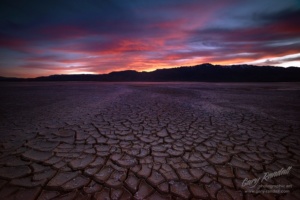
Early Spring is a good time to explore those places that heat up during the summer. The Alvord Desert is a great example. The mud tiles of the playa start to form as the mud starts to dry and the skies give you a good chance for a sunset at that time of the year as well.
To get this photo I had set up for a sunset and then waited. The sunset was nice that night, but the color didn’t come on in a dense colorful way until after I watched the “first sunset” fade and I had started to pack my gear into my Jeep. This second sunset is the result of the last beams of light shining from below the horizon and up under the clouds that were in front and above us. Always stay until the end of the show.
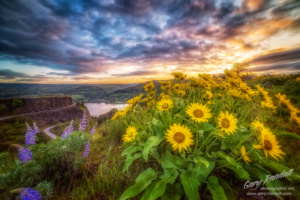
As the year progressed the anticipation of flowers increased. Not every year is a good year for flowers in the Mount Hood area, including the Columbia River Gorge. Weather can take its toll on their fragile petals. It can also affect the timing of which bloom when. When it all comes together like it did this last Spring it creates perfect conditions for beautiful wildflower photos. The lupine and the balsamroot bloomed in unison.
To get this photo I got up before dark and drove from my home here on The Mountain over Highway 35 through the Hood River Valley in the rain. I didn’t hurry because of the weather. I did not anticipate a sunrise, but the closer that I got to The Gorge the more that it looked like the clouds might part so I decided to head to Rowena Crest. I arrived just in time for this sunrise. I was also fortunate that there was hardly a breeze in the air which helped me to get this photo without the struggle of needing a super fast shutter speed or an open aperture. This allowed me to get a clear and sharp image through the scene.

I like sunrises. I just wish that they weren’t in the morning, but that they are limits the amount of people there to photograph them. I love Smith Rock any time of the day. I wanted to get the morning light as it shown onto the rocks I also wanted to take advantage of the foreground in this spot at this beautiful location.
To get this photo I drove out in the dark to the Smith Rock State Park and found these cracks that I found from a previous trip. This photo was all about composition and, of course, the warm light as it painted the side of the cliffs beyond. I set my tripod up to bridge the crack allowing it to move through the center of the photo, and took care not to fall down into the approximately 15 foot drop below. Because the foreground is so prominent I maximized my focus by stopping (smaller aperture opening) down and then made sure that it was in sharp focus.

The Columbia Hills of Washington, with views of Mount Hood and the Columbia River beyond, is one of my favorite places to go run through fields of flowers in the Springtime. Columbia Hills State Park is located in Dallesport Washington. It includes the historic Dalles Mountain Ranch and fields and fields of flowers. This old car makes a great subject of interest in photos made of it, especially on a beautiful sunny day with cotton ball clouds floating by.
To get this photo I was able to hand hold my camera due to the bright light of the sunshine. With such bright light my shutter speed was fast enough that it was just a matter of walking around and looking for thoughtful compositions.

I’m a guide and photography instructor. I love taking people from all over the world to places in and around the Mount Hood area. Less than an hour away we have a whole different world to explore by heading east toward open skies and Central Oregon. This photo is one that I used to demonstrate my focusing techniques. My goal was to get the wheat in front of the camera as well as the house behind in perfect focus.
To get this photo I set my camera on my tripod to give me a stable platform to allow me to take my time with my composition and adjustments. There was also a bit of a breeze so it allowed me to repeat the shot if it didn’t turn out the first, second or third try. I stopped down my aperture to maximize the focal distance, moved my focus out to infinity and then focused back until the wheat became tack sharp. Set my exposure and took the shot.
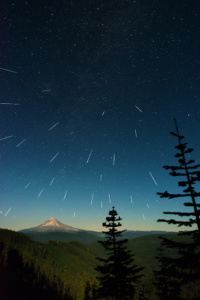
Every year I do my best to get a photo of the Perseid Meteor Shower. I enjoy photographing it because it happens in a arm time of the year and I stay up all night doing it. Sitting out on a dirt road in a lawn chair, under a blanket watching falling stars is a great way to spend time.
To get this photo I literally stayed up all night. This is a composite of about four hours of meteors that fell in front of my camera. Each photo is a 30 second exposure which allowed me to give the camera time to catch the falling stars. To get a constant sequence of images to cover the whole time I set the interval timer to take one shot after the other. Once I got back home I selected each of the photos that had a meteor in it and then layered each one on top of another as layers in Photoshop. I then masked out everything but the meteor. I then rotated each one according to the amount of time that had lapsed to compensate for the rotation of the Earth. The last step was to combine them all into one base image of Mount Hood taken that night. There’s a lot of work to get a photo like this but in the end I find it worth the effort.
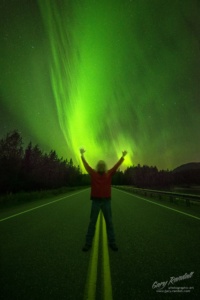
Standing under the Aurora Borealis is an incredible experience. All of my life it has fascinated me. I was fortunate to be able to travel to Alaska to see them this year as a part of a Photography Workshop that I hosted there.
To get this photo I used my tripod and remote shutter release. Because this was a night with no moon the only light was from the northern lights above me. I put my camera on the tripod, set it to a fairly high ISO, opened up my aperture to about f/3.5 and my exposure to about 10 seconds and then attempted to stand still while the camera exposed the image. I wouldn’t recommend standing in the middle of a road to get a photo, but this was Alaska. We saw no other cars at all that night.
And speaking of Alaska, here’s a photo of my workshop members. I took this photo as we were making our way across the ice of the Matanuska Glacier. In all we spent three days exploring this amazing place. As tour leader I was able to lead everyone out to a spot inside the heart of the ice to get amazing photos of a real Alaskan glacier up close and personal.
To get this photo I turned behind me to see them all coming over this crest of ice. I asked them to stop as I set my camera to Aperture Priority, opening my aperture and setting my ISO at about 800 to insure a fast enough shutter and then snapped a series of photos, taking this one as the best of the group. Although Landscape photographers typically prefer to set their cameras manually, there are times when you have to work quick so it’s perfectly acceptable to switch to a more automatic mode such as Aperture or Shutter Priority to insure that you get the photo.
